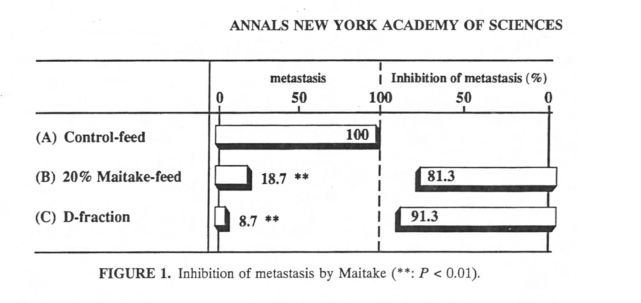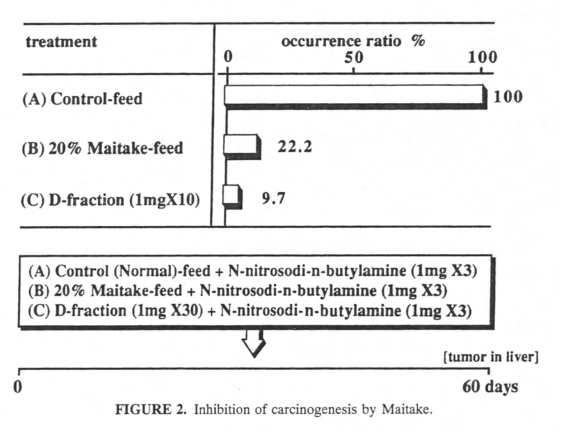舞茸蛋白多糖抑制细胞癌变和癌细胞转移
日期:2019-07-31 / 人气:
声明:本文摘自Annals of the New York Academy of Sciences,即纽约科学院年报,是美国历史最悠久的连续出版的科学期刊,也是全球被引用最多的跨学科期刊。从1823年开始,纽约科学院年报定期出版特殊领域的专题文章,包括生物医学、生物学以及心理学、人类学和哲学。为方便广大读者阅读,我们对本文部分内容进行了中文翻译,译文仅供参考,如有不足之处,敬请指正。
【参考译文】
Activity of Maitake D-fraction to Inhibit Carcinogenesis and Metastasis
舞茸蛋白多糖抑制细胞癌变和癌细胞转移
DISCUSSION翻译参考
讨 论
自从80年代中期,舞茸强大的抗肿瘤活性已被高度重视并受到了很多研究人员的关注。我已发表过报告:由具有(1,3)支链的β-(1,6)-葡聚糖组成的舞茸葡聚糖具有很强的激活细胞免疫活性功能,这个葡聚糖是舞茸比以前研究的其他任何药用菇抗肿瘤活性优越的原因。我还发现了,在舞茸的不同组分中,酸不溶性,碱溶性的热水提取组分,即舞茸蛋白多糖是口服给药最有效的组分。
在上述实验中,口服舞茸蛋白多糖组抑制了91.3%的癌细胞转移。喂食舞茸组也显示出了81.3%的癌细胞转移抑制率,这表明了舞茸强大的抗癌细胞转移能力。另外,第二个试验结果表明了舞茸预防正常细胞癌变的能力,结果是相当振奋人心的,并提示在当今日常饮食中存在大量致癌物的环境里,舞茸可大大降低了患癌的风险。
【论文原文】
Reprinted from Cancer Prevention
Volume 768 of the Annals of the New York Academy of Sciences
September 30, 1995
Activity of Maitake D-fraction to Inhibit
Carcinogenesis and Metastasis
HIROAKI NANBA
Department of Microbial Chemistry
Kobe Pharmaceutical University
Kobe 658, Japan
I have been involved in research on medicinal properties of edible mushrooms for the
last 15 years and have reported that, of all medicinal mushrooms studied, Maitake
mushroom (Grifola frondosa) has the strongest antitumor activity in tumor growth
inhibition both when administered orally and intraperitoneally.1-3 In fact, most of the
other mushroom extracts are reported ineffective when given orally.4,5 In this report, I
have investigated Maitake's activities on the inhibition of carcinogenesis and formation
of the secondary focus due to metastasis of tumor cells in lymph and blood.
MAITAKED-FRACTION
The D-fraction of Maitake extract was acquired as follows: Fruit bodies of Maitake
were treated with hot water and the water-soluble fraction was saturated to 80% with
ethyl alcohol. Then, the precipitate was treated with acetic acid and alkalic material. The
obtained acid-insoluble, alkali-soluble fraction was charged on a Sepharose column
chromatography. The acquired deproteined fraction is 1,6-beta-glucan carrying 1,3-
branched chains, with a molecular weight of about 1,000,000. It has been named Maitake
D-fraction and has been used in this research.
DOSE IT STOP THE METASTASIS OF CANCER CELLS?
The test was conducted in the following manner: MM-146 liver carcinoma (1 x 10
cells) was injected into the left rear footpad of mice and the footpad was cut off after 48
hours. Then, normal feed was given to the control group (A), 20% Maitake powder was
given to group B, and 1 mg/kg of D-fraction was intraperitoneally given ten times to
group C with normal food. All three groups were bred for another 30 days and the
number of tumor foci metastasized in the liver were counted by stereoscope wide field
microscopy. It is observed that the metastasis to the liver was prevented by 91.3% by
the administration of D-fraction and by 81.3% by the oral administration of Maitake
powder (FIGURE 1). The result indicates that tumor cells present in blood and/or lymph
were necrotized by the activated cellular immune-competent cells.
DOSE IT ALAO PREVENT CARCINOGENESIS IN NORMAL CELLS?
A test was also conducted to see if D-fraction can prevent carcinogenesis in normal
cells. As a carcinogen, 1 mg of N-nitrosodi-n-butylamine was given in the food three

times at 7-day intervals. The control group was bred with normal feed (A), group B was
fed with 20% Maitake powder, and group C was orally administered 1 mg/kg of
D-fraction given 30 times. After 60 days, the number of tumors occurring in the liver
were counted. The occurrence rates of liver cancer in the D-fraction group (C) and the
20% Maitake-feed group (B) were 9.7% and 22.2%, respectively, when the number of
tumor cells in control group (A) was set as 100% (FIGURE 2).

NANBA: MAITAKE D-FRACTION
DISCUSSION
Since the mid-1980s, Maitake's strong antitumor activity has been paid keen atten-
tion and has been focused upon by many researchers.1-3,6-8 I have reported that poly-
saccharides of Maitake consisting of a beta-l,6-linked glucan with 1,3-branches possess
a strong ability to activate cellular immunity, which causes the superior antitumor
activity compared to any other medicinal mushrooms studied previously.2,3 I have also
announced that, among various fractions of Maitake extracts, the acid-insoluble, alkali-
soluble, hot-water-extractable fraction, D-fraction, is most potent when orally admin-
Istered.9
In the above test, the cancer metastasis was prevented by 91.3% by the oral admin-
istration of D-fraction. The Maitake-fed group also demonstrated an impressive 81.3%
prevention, indicating Maitake's strong ability to inhibit cancer metastasis. Also, the
result of the second test indicates its ability to prevent carcinogenesis in normal cells.
This is encouraging because the result suggests that Maitake is effective in reducing the
cancer occurrence risks substantially in today's environment where plenty of carcino-
genic foods exist in our daily diet.
REFERENCES
1、MORI, K . , T. TOYOMATSU, H . NANBA & H. KURODA. 1986 (July). Antitumor activities of
edible mushrooms by oral administration. Int. Symp. Sci. Tech. Pennsylvania University.
2、NANBA, H., A . HAMAGUCHI & H. KURODA. 1987. The chemical structure of an antitumor
polysaccharide in fruit bodies of Grifola frondosa (Maitake). Chem. Pharm. Bull. 35(3):1162-1168.
3、NANBA, H . 1993. Antitumor activity of orally administered "D-fraction" from Maitake
mushroom (Grifola frondosa). J. Naturopathic Med. 1(4): 10-15.
4、OHNO, N., K. ITO, T. TAKEYAMA, I. SUZUKI, K. SATO, S. OIKAWA & T. MIYAZAKI. 1985.
Chem. Pharm. Bull. 33: 3395.
5、MIZUNO, T., K. OHSAWA, N. HAGIWARA & R. KUBOYAMA. 1986. Agric. Biol. Chem. 50:1679.
6、ADACHI, K . , H . NANBA & H. KURODA. 1987. Potentiadon of host-mediated andtumor
activity in mice by P-glucan obtained from Grifola frondosa (Maitake). Chem. Pharm.Bull. 35 (1): 262-270.
7、IiNO, K . , N. OHNO, I. SUZUKI, K. SATO, S. OIKAWA & T. YADOMAE. 1985.Structure-function
relationship of antitumor beta-l,3-glucan obtained from matted mycelin of cultured Grifola frondosa. Chem. Pharm. Bull. 33(11): 4950-4956.
8、TAKEYAMA, T., I. SUZUKI, N. OHNO, S. OIKAWA, K . SATO, M . OHSAWA & T. YADOMAE.1987.
Host-mediated antitumor effect of Grifolan NMF-5N, a polysaccharide obtained from Grifola frondosa. J. Pharmacobio-dyn. 10: 644—651.
9、HISHIDA, I., H. NANBA & H. KURODA. 1988. Antitumor activity exhibited by orally
administered extract from fmit body of Grifola frondosa (Maitake). Chem. Pharm. Bull.
36(5): 1819-1827.
本文部分内容来源网络,如有侵权请联系删除,谢谢。
本文部分内容来源网络,如有侵权请联系删除,谢谢。
编辑:中润世源
